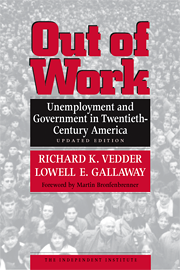Bill Clinton correctly showed during the presidential campaign that virtually no jobs had been created during President Bush’s tenure in the White House. While on average roughly two million jobs a year had been created in the United States from 1970 to 1989, job expansion has been virtually nil since.
The newly elected president has made it clear that doing something about jobs and the economy is his top priority. But as we demonstrate in our book, Out of Work: Unemployment and Government in Twentieth-Century America (New York: Holmes & Meier), published for the Oakland, California-based Independent Institute, the best Clinton strategy would be to move decisively to end the government programs that have created this situation.
When presidents have let labor markets operate without interference, such as after both world wars, the economy adjusts quickly to changing circumstances. When there is massive intervention, such as by Presidents Hoover and Roosevelt during the Great Depression, the nation suffers prolonged unemployment.
The famous Law of Demand applies to labor markets. When labor is less expensive, more of it is hired. When the cost of hiring workers rises, less hiring is done.
What turned a modest recession in the late 1920s into the Great Depression was a governmentally supported high wage policy that priced labor out of the market. Likewise, the 1990 recession was partially triggered by a large increase in wages.
During the great economic expansion from 1983 to 1989, hourly wage costs (including fringe benefits) rose slightly over four percent a year. After allowing for inflation and some increase in the productivity of workers, labor costs actually fell as a percentage of sales, making hiring more attractive.
But beginning at the end of 1989, hourly wage costs started to rise faster, and then soared at an annual rate of eight percent in the second quarter of 1990. Why? One major factor was the 13.4 percent increase in the federal minimum wage that took effect on the first day of that quarter.
Soaring labor costs reduced employment. In time, this led to smaller wage increases, setting the stage for a market-induced recovery. Then, on April 1, 1991, another large increase in the federal minimum wage forced labor costs to rise for a time at over a five percent annual rate, thwarting a recovery.
Other recent legislation has also aggravated joblessness. On three occasions, for example, Congress extended unemployment insurance benefits, making the unemployed more finicky about the work that they would accept and raising what economists call the “reservation” (the minimally accepted wage) of the unemployed, further retarding job growth.
To have both new job opportunities and a rising standard of living, labor productivity—the output per hour worked—must rise. In recent years, several pieces of new legislation retarded productivity growth, such as the 1990 amendments to the Clean Air Act, the Americans With Disabilities Act, and the 1991 Civil Rights Act.
By restricting the ability of employers to utilize labor and capital inputs as they would like, new regulations arising from these laws reduce the ability of employers to cut labor costs.
President-elect Clinton’s promises do not seem likely to alleviate unemployment.
Clinton favors indexing the minimum wage, allowing it to rise on a continual basis. His health care proposals will lead to a huge increase in the cost of fringe benefits associated with health care, which can only be financed by lowering money wages, by raising prices, or by reducing profits, the latter leading to a reduction in jobs. And the higher income taxes he has in mind will only reduce labor inputs.
As for Clinton’s proposed spending on “infrastructure” (i.e., political pork barrel), the evidence is not encouraging: massive public works spending in the 1930s was accompanied by an unemployment rate languishing in double digits for a decade.
The nation’s fundamental economic problem is stagnating labor productivity. Since 1970, labor productivity has risen less than one percent a year in the United States, compared with over three percent growth from 1947 to 1970.
Higher productivity lowers labor costs per dollar of sales revenue, providing incentives for firms to hire more labor and creating pressures for higher real wages. Higher labor productivity, in turn, requires ending punitive tax laws restricting capital formation as well as providing new incentives to save.
Higher labor productivity also requires an end to well intended regulatory initiatives that lower output per worker.
Future significant job growth will require liberating labor markets from oppressive constraints imposed by government. If the Clinton administration fails to do so, his 1992 campaign rhetoric will return to haunt him in 1996.









